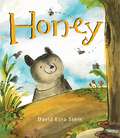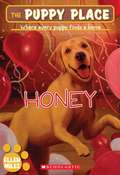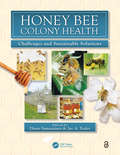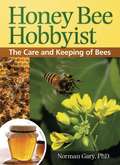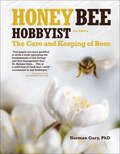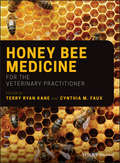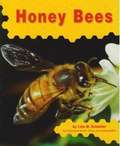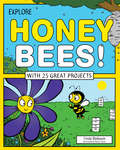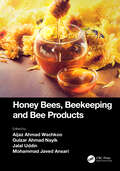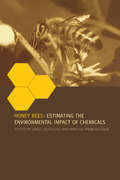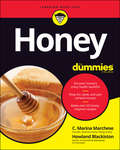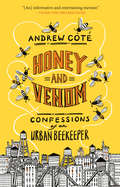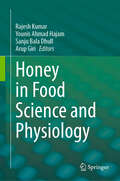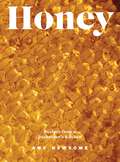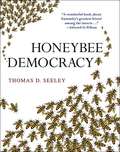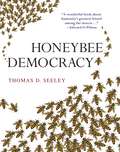- Table View
- List View
Honey
by David Ezra SteinThis sweet companion to David Ezra Stein's award-winning Leaves celebrates the joy of savoring something you love.Bear is ravenous when he wakes up from his winter sleep and has one thing on his mind: honey! Alas, it is too soon for honey, so Bear tries hard to be patient. The world around him is waking up, too, and he soon remembers all the other things he loves, like warm grass, berries, and rain. He's almost content, until, one day, he hears a welcome buzzing sound . . . and finally it is time for Bear to delight in the thing he relishes above all others--and it is as warm, golden, sweet, and good as he remembered.
Honey & Leon Take the High Road
by Alan CummingAlan Cumming and Grant Shaffer's world-traveling dogs are back...and off to Scotland! When Honey falls in love with a handsome Scottish pup, will Leon be able to protect their dads on his own?Honey and Leon have done a very good job of keeping their dads safe--but now the dads have decided to travel again! So the two loyal dogs pack up their disguises and secretly follow them all the way to Europe on a Scottish Highland adventure. All is going according to plan...until Honey becomes besotted with a charming Scottish dog named Coll! Can Leon manage to keep their dads out of trouble on his own while Honey is gallivanting with her new beau? Actor Alan Cumming and artist Grant Shaffer bring to life the imagined secret identities of the two dogs they once owned. Hilarious, sassy dialogue and wild escapades make this an unmissable read-aloud, perfect for families who love to put on a show!
Honey (The Puppy Place #16)
by Ellen MilesPuppy love in Puppy Place! An irresistible Valentine's Day story starring Honey, a sweet yellow Lab. In this special Valentine's Day story, Charles and his best friend Sammy meet Honey, a sweet, intelligent yellow Lab who's family is moving away--without Honey! When Charles brings this puppy home, guess who falls in love? Charles's mom--the cat lover of the family! Will the Petersons end up keeping Honey? Or will Honey become a service dog and best pal for Noah, a talented artist who uses a wheelchair? One thing is for certain: puppy love is in the air!
Honey Bee Biology
by Brian R. JohnsonThe most comprehensive and up-to-date general reference book on honey bee biologyHoney bees are marvelously charismatic organisms with a long history of interaction with humans. They are vital to agriculture and serve as a model system for many basic questions in biology. This authoritative book provides an essential overview of honey bee biology, bringing established topics up to date while incorporating emerging areas of inquiry.Honey Bee Biology covers everything from molecular genetics, development, and physiology to neurobiology, behavior, and pollination biology. Placing special attention on the important role of bees as pollinators in agricultural ecosystems, it incorporates the latest findings on pesticides, parasites, and pathogens. This incisive and wide-ranging book also sheds vital light on the possible causes of colony collapse disorder and the devastating honey bee losses we are witnessing today.The study of honey bees has greatly expanded in recent years and there is more interest in these marvelous creatures than ever before. Honey Bee Biology is the first up-to-date general reference of its kind published in decades. It is a must-have resource for social insect biologists, scientifically savvy beekeepers, and any scientist interested in bees as a model system.
Honey Bee Colony Health: Challenges and Sustainable Solutions
by K. M. M. PrabhuThis book summarizes the current progress of bee researchers investigating the status of honey bees and possible reasons for their decline, providing a basis for establishing management methods that maintain colony health. Integrating discussion of Colony Collapse Disorder, the chapters provide information on the new microsporidian Nosema ceranae pathogens, the current status of the parasitic bee mites, updates on bee viruses, and the effects these problems are having on our important bee pollinators. The text also presents methods for diagnosing diseases and includes color illustrations and tables.
Honey Bee Hobbyist
by Norman GaryBee keeping isn't just for the professional farmer-bees can be kept in any situation from the simple backyard patio and garden to large expanses of farm land. This comprehensive and attractive beekeeping guide, from Hobby Farm Press, the same people who bring you Hobby Farms and Hobby Farm Home magazine, Beekeeping takes readers from finding their bees, housing them, collecting honey and using their produce for pleasure and possible profit. This colorful book, including entertaining chapters on the history of bees and beekeeping, serves as an extensive introduction to help novice beekeepers fully understand this exciting hobby!
Honey Bee Hobbyist: The Care and Keeping of Bees
by Norman GaryA beginning apiarist’s comprehensive guide to keeping bees at home, from basic bee biology to the necessary tools, and more.Discover the secrets of successful hobby beekeeping with advice from a world-renowned honey bee expert. Dr. Norman Gary shares his extensive beekeeping expertise in this entertaining and authoritative guide. Honey Bee Hobbyist, 2nd Edition will help you decide whether hobby beekeeping is right for you and will introduce you to all of the equipment, tools, and protective clothing you’ll need to get started.Dr. Gary teaches you to understand bee behavior so you can relax and enjoy working with these amazing creatures. He takes you from assembling your new hive and stocking it with bees to managing a growing colony and harvesting your honey rewards. With fascinating color photographs, myth-busting insights, and never-before-published tips, this comprehensive handbook is your first step toward an enjoyable and rewarding lifelong hobby.Inside you’ll find:Detailed, practical instructions for hobby beekeepingBasics of honey bee anatomy, behavior, and reproductionHow to use a bee smoker and safely open a hiveHow to monitor hive conditions, prevent swarming, and deal with bee diseasesEffective sting-prevention strategiesFun ways to use your beekeeping hobby for entertainment and educationUpdated information on beekeeping in urban environments“Few people are more qualified to write a book explaining the fundamentals of bee biology and hive management than Dr. Norman Gary… This is a solid how-to book that I could recommend to any beekeeper.”—Dr. James E. Tew, The Ohio State University“As practical as it is engaging, Honey Bee Hobbyist by University of California, Davis, entomologist Norman Gary can help you decide if backyard beekeeping is for you and how to go about it. Learn all about these important pollinators, including the intricacies of bee reproduction and society, how to use surplus honey, and why most people shouldn’t be overly afraid of a bee’s sting.”—California Bountiful Magazine
Honey Bee Medicine for the Veterinary Practitioner
by Terry Ryan Kane Cynthia M. FauxAn essential guide to the health care of honey bees Honey Bee Medicine for the Veterinary Practitioner offers an authoritative guide to honey bee health and hive management. Designed for veterinarians and other professionals, the book presents information useful for answering commonly asked questions and for facilitating hive examinations. The book covers a wide range of topics including basic husbandry, equipment and safety, anatomy, genetics, the diagnosis and management of disease. It also includes up to date information on Varroa and other bee pests, introduces honey bee pharmacology and toxicology, and addresses native bee ecology. This new resource: Offers a guide to veterinary care of honey bees Provides information on basic husbandry, examination techniques, nutrition, and more Discusses how to successfully handle questions and ‘hive calls’ Includes helpful photographs, line drawings, tables, and graphs Written for veterinary practitioners, veterinary students, veterinary technicians, scientists, and apiarists, Honey Bee Medicine for the Veterinary Practitioner is a comprehensive and practical book on honey bee health.
Honey Bees
by Jane LechtHoneybees work very hard every day. Find out what they do, and why they do it. Find out how they live and how hard they work.
Honey Bees (Honey Bees Series)
by Gail Saunders-Smith Lola SchaeferSimple text and photographs introduce the body parts of honeybees.
Honey Bees!
by Cindy BlobaumWhat did you have for breakfast this morning? Toast, cereal, juice, and fruit? Thank the honey bees! About one out of every three mouthfuls we eat is affected by honey bee pollination. In Explore Honey Bees! With 25 Great Projects, young readers learn about honey bee colonies, why honey bees live in hives, how honey bees communicate with each other, and why they are so important to human lives. Colony collapse disorder first appeared in 2006 and since then beekeepers have seen disappearances of 30 to 90 percent of their bee colonies each year. Readers learn about possible reasons behind and solutions to this growing global problem. Explore Honey Bees! offers a glimpse into a miniature world familiar to children. Activities include designing a hive and making a model of a flower’s reproductive system, reinforcing the math and science skills readers gain from the text. Fun facts and colorful illustrations make learning fun and exciting. Links to online primary sources integrate a digital learning experience and offer opportunities to delve deeper into the world of honey bees. This title meets Common Core State Standards in language arts, science and technology; Guided Reading Levels and Lexile measurements indicate grade level and text complexity.
Honey Bees, Beekeeping and Bee Products
by Aijaz Ahmad Wachkoo, Gulzar Ahmad Nayik, Jalal Uddin and Mohammad Javed AnsariHoney bees are social insects; they live together in large, well-organized family groups comprising three castes: queen (fertile female), workers (sterile females) and drones (males). During honey flow season, there is a considerable increase in the foraging activity of the workers and in the rate of egg laying by the queen. Sex determination in honey bees involves a multi-allelic locus, such that homozygotes develop as males and heterozygotes as females, whereas diet quality influences the caste determination in honey bees. Like all living organisms, honey bees can be infested with diseases and pests. Some of these are more deleterious to bee colonies than others, but it is important for the beekeeper to be able to recognize conditions that might be disease or pest-related and respond accordingly so as to improve the quality of honey and honey bee by-products.The best-known primary products of beekeeping are honey and wax, but pollen, propolis, royal jelly, venom, queens, bees and their larvae are also marketable primary bee products. The purpose of this book is to make available information on bee biology and beekeeping as well as to provide comprehensive information on manufacturing, processing and marketing of value-added bee products.This book has been designed as a useful tool for the many diverse professionals who characterize and market honey bee products, including beekeepers, non-beekeepers, small entrepreneurs, extension officers and those involved in small business development. This edited book will be the first of its kind to contain comprehensive information on both bees and bee products.Key Features: Contains comprehensive information on beekeeping. Discusses the recent advances in beekeeping. Sheds light on bee colony integration and organization. Contains brief information on honey bee products.
Honey Bees: Estimating the Environmental Impact of Chemicals
by James Devillers Minh-Hà Pham-DelègueHoney Bees: Estimating the Environmental Impact of Chemicals is an updated account of the different strategies for assessing the ecotoxicity of xenobiotics against these social insects, which play a key role in both ecology and agriculture. In addition to the classical acute laboratory test, semi-field cage tests and full field funnel tests, new te
Honey Bees: Letters from the Hive
by Stephen Buchmann Banning RepplierIn Honey Bees: Letters From the Hive, bee expert Stephen Buchmann takes readers on an incredible tour. Enter a beehive--one part nursery, one part honey factory, one part queen bee sanctum--then fly through backyard gardens, open fields, and deserts where wildflowers bloom. It's fascinating--and delicious! Hailed for their hard work and harmonious society, bees make possible life on earth as we know it. This fundamental link between bees and humans reaches beyond biology to our environment and our culture: bees have long played important roles in art, religion, literature, and medicine--and, of course, in the kitchen. For honey fanatics and all who have a sweet tooth, this book not only entertains and enlightens but also reminds us of the fragility of humanity's relationship with nature.
Honey Bunch and Norman Visit Beaver Lodge (Honey Bunch #34)
by Helen Louise ThorndykeHoney Bunch Morton--whose real name is Gertrude Marion Morton, although nobody ever calls her that--is a six-year-old girl off on another adventure with her six-year-old neighbor playmate, Norman Clark.<P>Norman sees a big swimming cat down at Barham Pond and Honey Bunch wants to see it for herself, knowing cats don't like water. Henry, the "Park Custodian" tells the children that the "cat" is actually "Mr. Slapper", a beaver caught by a trapper friend of Henry's. But the friend was moving and couldn't keep the beaver as a pet any more. So the friend gave the beaver to Barham Park. Then Henry tells the children "Beavers like company. We should really have another beaver so that Mr. Slapper would have a playmate."<P>Honey Bunch gets an idea that she and Daddy and Mother and Norman could go on a vacation to a place where there were beavers. Then she might find a playmate to bring back for Mr. Slapper... <P>"Honey Bunch #34", aka "Honey Bunch and Norman #6".<P>"Helen Louise Thorndyke" is a pseudonym of "Harriet S. Adams".
Honey For Baby Bear (Rigby PM Platinum #Blue (Level 9-11))
by Beverley Randell Isabel LoweBaby Bear goes into the forest to look for honey, and can't find his way home.
Honey For Dummies
by Howland Blackiston C. Marina MarcheseGet in on the ground level of the next artisan food obsession—honey! Just like wine, cheese, beer or coffee, honey is an artisan food with much to be discovered. Whether you're interested in tasting the various varietals, using it as a cure, or harvesting your own, Honey For Dummies is the guide for you. This book reveals the deep and complex world of honey, its diverse floral sources, and its surprising range of colors, smells, and flavors. You will learn about over 50 single-origin honeys, their sensory profiles, where they are produced and where to buy them. Discover how to taste and evaluate honey using the same methods as professional honey sensory expert. Understand how honey is produced by honeybees, and how beekeepers harvest, and bottle this liquid gold. You'll also discover the historical role honey has played around the world in folklore, religions, and economies. From its health benefits, to recipes, to food pairings, this complete guide covers all things honey! Honey is the latest food trend that can be found at farmers' markets, specialty food shops and on the menu of restaurants. It is produced from bees in every state and just about every country on the planet. Let Honey For Dummies accompany you on your sweet adventure! Discover the rich and complex world of single-origin honey Learn about honey's composition and its myriad health benefits Acquire the skills to taste honey like a pro then how to perfectly pair honeys with all foods Try the book's many wonderful recipes that incorporate honey Honey For Dummies is the perfect companion for every chef, brewer, homesteader, beekeeper or honey lover.
Honey and Venom: Confessions of an Urban Beekeeper
by Andrew CotéA year in the life of New York City&’s premier beekeeper, who chronicles his adventures and the quirky personalities he encounters while spreading his infinite knowledge of and passion for the remarkable honey bee. &“Coté&’s charming and poignant essay collection delivers the entertainment and smarts required to make real change in how we look at our planet—and ourselves.&”—Andrew ZimmernConsidered an &“industry legend&” by The New York Times, Andrew Coté has one of the most intriguing, challenging, and unique jobs in New York City—maintaining millions of honey bees atop some of the city&’s most iconic buildings. His apiaries have crowned the Waldorf Astoria and the Museum of Modern Art; reside on the North Lawn of the United Nations; reign above stores, hotels, restaurants, schools, churches, and synagogues; and are situated in community gardens, and even cemeteries, throughout the five boroughs. In this debut collection, Coté takes readers with him on his daily apiary adventures over the course of a year, in the city and across the globe. Here, among his many duties, he is called to capture swarms that have clustered on fire hydrants, air-conditioning units, or street-vendor umbrellas. Annually, he travels with his father to regions like remote Fijian islands, rural Uganda, Haiti, Ecuador, or Iraq with his organization, Bees Without Borders, where he teaches beekeepers how to increase their honey yield and income via beekeeping endeavors. Written with Coté&’s trademark humor, acumen, and a healthy dose of charm, Honey and Venom illuminates the obscure culture of New York City &“beeks&” and the biology of the bees themselves, from the humble drone to the fittingly named worker to the queen herself—who is more a slave than a monarch. The hive world, Coté reveals, is full of strivers and slackers, givers and takers, and even some insect promiscuity—startlingly similar to the prickly human variety. For Coté, a fourth-generation beekeeper, this is a family tradition, and this personal significance pervades his celebration of the romance and mystery of bees, their honey, and the beekeepers whose lives revolve around these most magical creatures.
Honey in Food Science and Physiology
by Rajesh Kumar Sanju Bala Dhull Younis Ahmad Hajam Arup GiriThis book highlights the science underlying honey, which is central to an understanding of conventional medicine or ingredients of food used mostly in all societies and it is attracting increasing interest among food scientists and professionals worldwide. Honey, wax, propolis and royal jelly also have significant roles in various nutraceutical and pharmaceutical products and this book provides collective information and practical approaches regarding all characteristic features of honey and its applications as functional food and medicines. Not only does this book explain the comprehensive knowledge of honey and its medicinal properties based on current researched evidence, it also explores the contribution of honey in the food science and medicine industry as a significant part of nutraceuticals and functional food research. Written by leading scientists in the field, the book will be a valuable resource for students and researchers in the fields of food chemistry, nutritional science, taste physiology, and neuroscience, as well as for professionals in the food industry.
Honey... Honey... Lion!
by Jan BrettThe African plains provide a stunning environment for Jan Brett's latest animal adventure. For as long as anyone can remember, the honeyguide bird and the African honey badger have been partners when it comes to honey:Honeyguide finds the honeycomb, Badger breaks it open, and they share the sweetness inside.But this day, Badger keeps all the honey for himself. Foolish Badger!In no time, Honeyguide leads Badger on a fast chase. Badger thinks it's for honey; but Honeyguide has a surprise waiting for her greedy friend.As they swim across a pond, push through a thicket of reeds, leap over a huge anthill, a menagerie of exotic animals passes the news along in a kind of animal Bush Telegraph. Finally Badger faces a lift-the-flap page, revealing the twist that teaches Badger a lesson. Can you guess who's under that flap?Honey . . . Honey . . . Lion! will surely become a family favorite for readers of all ages.
Honey: From Flower to Table
by Stephanie Rosenbaum“Stephanie Rosenbaum gives all the buzz about honey, including chapters on history, cooking and crafting.” —Publishers WeeklyIn the winning format of the highly successful The Lavender Garden, Honey: From Flower to Table dips into the myth, magic, science, and literature behind this sacred and sensuous food. Author Stephanie Rosenbaum traces the amazing process that turns flower nectar into honey, and takes the reader on a fascinating tour of the history and symbolism of honey. Cooking and crafting chapters include recipes for mouthwatering honey delicacies and step-by-step instructions for simple crafts like honeycomb candles and lip balms. A sumptuous feast for the senses, Honey makes a perfect gift for Mother’s Day, honey lovers, or anyone who fills life with sweet inspiration.
Honey: Honey (The Puppy Place #16)
by Ellen MilesWelcome to the Puppy Place--where every puppy finds a home!In this special Valentine's Day story, Charles and his best friend Sammy meet Honey, a sweet, intelligent yellow Lab who's family is moving away--without Honey! When Charles brings this puppy home, guess who falls in love? Charles's mom--the cat lover of the family! Will the Petersons end up keeping Honey? Or will Honey become a service dog and best pal for Noah, a talented artist who uses a wheelchair? One thing is for certain: puppy love is in the air!
Honey: Recipes From a Beekeeper's Kitchen
by Amy NewsomeWINNER OF THE 2024 GUILD OF FOOD WRITERS AWARD FOR SPECIALIST OR SINGLE SUBJECT COOKBOOK"Amy's beautiful recipes are an ode to the pleasures of cooking with honey and the importance of it in our lives." – Thomasina Miers"Something truly magical happens when beekeeping, gardening and cooking meet, and in that intersection stands Amy with this wonderful book." – Itamar Srulovich, Honey & Co."A beautiful, thoughtful exploration of keeping bees and cooking with honey – with such enticing recipes." – Mark DiaconoA sticky celebration of honey from bloom to plate, with 80 inspiring recipes straight from a beekeeper’s kitchen. Amy Newsome is a cook, gardener and beekeeper – and this is her homage to honey and its deliciously distinct varietals from around the globe. Marvel at the floral intricacies of honey’s terroir and all its wonderful flavours, before getting stuck in with 80 sweet and savoury recipes that celebrate the magic of cooking with honey; from honey ferments, fancy fritto misto and Honeyed Chipotle Lamb Tacos, to Saffron & Apricot Honey Buns, Eucalyptus Honey Granita and a Bergamot Bee's Knees to wash everything down. Covering the beekeeper’s year and how honey is made, you will journey through the changing seasons, take a peak inside the hive and discover just how to create the perfect bee-friendly garden. This cookbook is an incredibly thoughtful collection of recipes and stories that offers an inspiring glimpse into the craft of beekeeping and the remarkable world of the honeybee, confirming why and how we should be treating honey with the respect it deserves.
Honeybee Democracy
by Thomas D. SeeleyHoneybees make decisions collectively--and democratically. Every year, faced with the life-or-death problem of choosing and traveling to a new home, honeybees stake everything on a process that includes collective fact-finding, vigorous debate, and consensus building. In fact, as world-renowned animal behaviorist Thomas Seeley reveals, these incredible insects have much to teach us when it comes to collective wisdom and effective decision making. A remarkable and richly illustrated account of scientific discovery, Honeybee Democracy brings together, for the first time, decades of Seeley's pioneering research to tell the amazing story of house hunting and democratic debate among the honeybees. In the late spring and early summer, as a bee colony becomes overcrowded, a third of the hive stays behind and rears a new queen, while a swarm of thousands departs with the old queen to produce a daughter colony. Seeley describes how these bees evaluate potential nest sites, advertise their discoveries to one another, engage in open deliberation, choose a final site, and navigate together--as a swirling cloud of bees--to their new home. Seeley investigates how evolution has honed the decision-making methods of honeybees over millions of years, and he considers similarities between the ways that bee swarms and primate brains process information. He concludes that what works well for bees can also work well for people: any decision-making group should consist of individuals with shared interests and mutual respect, a leader's influence should be minimized, debate should be relied upon, diverse solutions should be sought, and the majority should be counted on for a dependable resolution. An impressive exploration of animal behavior, Honeybee Democracy shows that decision-making groups, whether honeybee or human, can be smarter than even the smartest individuals in them.
Honeybee Democracy
by Thomas D. SeeleyHow honeybees make collective decisions—and what we can learn from this amazing democratic processHoneybees make decisions collectively—and democratically. Every year, faced with the life-or-death problem of choosing and traveling to a new home, honeybees stake everything on a process that includes collective fact-finding, vigorous debate, and consensus building. In fact, as world-renowned animal behaviorist Thomas Seeley reveals, these incredible insects have much to teach us when it comes to collective wisdom and effective decision making. A remarkable and richly illustrated account of scientific discovery, Honeybee Democracy brings together, for the first time, decades of Seeley's pioneering research to tell the amazing story of house hunting and democratic debate among the honeybees.In the late spring and early summer, as a bee colony becomes overcrowded, a third of the hive stays behind and rears a new queen, while a swarm of thousands departs with the old queen to produce a daughter colony. Seeley describes how these bees evaluate potential nest sites, advertise their discoveries to one another, engage in open deliberation, choose a final site, and navigate together—as a swirling cloud of bees—to their new home. Seeley investigates how evolution has honed the decision-making methods of honeybees over millions of years, and he considers similarities between the ways that bee swarms and primate brains process information. He concludes that what works well for bees can also work well for people: any decision-making group should consist of individuals with shared interests and mutual respect, a leader's influence should be minimized, debate should be relied upon, diverse solutions should be sought, and the majority should be counted on for a dependable resolution.An impressive exploration of animal behavior, Honeybee Democracy shows that decision-making groups, whether honeybee or human, can be smarter than even the smartest individuals in them.
